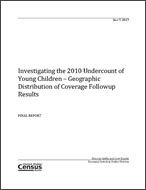
An official website of the United States government
Here’s how you know
Official websites use .gov
A .gov website belongs to an official government organization in the United States.
Secure .gov websites use HTTPS
A lock (
) or https:// means you’ve safely connected to the .gov website. Share sensitive information only on official, secure websites.
-
//
- Census.gov /
- Planning the Count /
- 2020 Census Final Analysis Reports /
- 2010 Undercount of Young Children – Geographic Distribution of Results
Investigating the 2010 Undercount of Young Children – Geographic Distribution of Coverage Followup Results
Investigating the 2010 Undercount of Young Children – Geographic Distribution of Coverage Followup Results
Introduction
Demographers have documented the high undercount of children under the age of 5 in decennial censuses (e.g., West and Robinson 1999, O’Hare 2015). Evaluations show that U.S. Census Bureau surveys, such as the American Community Survey, the Current Population Survey, and the Survey of Income and Program Participation, also undercount young children, which can result in biased survey estimates (O’Hare and Jensen 2014).
In this report, we define “young children” as children age 0 to 4. In 2010, the Census Bureau used two different methods to evaluate census coverage. A post-enumeration survey, the Census Coverage Measurement (CCM) program, used dual system estimation to measure net coverage error. In addition, Demographic Analysis (DA) provided independent estimates of net coverage error. In 2010, DA estimated a net undercount of about 4.6 percent for young children (Hogan et al. 2013). This translates into a net undercount of almost 1 million young children. O’Hare (2015) shows that the net undercount rate for young children in the decennial census increased from 1.4 percent in 1980 to 4.6 percent in 2010, while the net undercount rate for the adult population (age 18+) went from an undercount of 1.4 percent in 1980 to an overcount of 0.7 percent in 2010. This growth in the net undercount of young children is the motivation for this research.
The 2010 Census included a coverage improvement program to review the list of household members and identify suspected coverage errors for followup. Two recent reports summarized data from this Coverage Followup (CFU) operation. The first report (U.S. Census Bureau 2017a) looked at households that responded positively to one of the probes on the 2010 Census questionnaires about potentially omitted children. The report summarized the characteristics of households where the respondent was uncertain about including a child. The second report (U.S. Census Bureau 2017b) analyzed the characteristics of the young children added as a result of CFU and the characteristics of the households where they lived. Data from these two evaluations identified instances of potential coverage error involving young children.
In this report, we look at the geographic distribution of the CFU results, identifying areas with the greatest numbers and highest rates of positive responses to the child undercount probes and areas with the greatest numbers and proportions of their young children added as a result of the CFU operation. As we plan for the 2020 Census, it is useful to identify the geographic areas that experienced 2010 Census enumeration challenges involving young children. These areas could be targeted for special outreach and education efforts in 2020. Understanding common characteristics of these areas may help us better understand the reasons for the errors.
Share
Some content on this site is available in several different electronic formats. Some of the files may require a plug-in or additional software to view.
 Yes
Yes
 No
NoComments or suggestions?


Top

